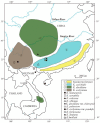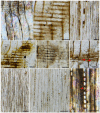Early Cretaceous Keteleerioxylon Wood in the Songliao Basin, Northeast China, and Its Geographic and Environmental Implications
- PMID: 36358325
- PMCID: PMC9687590
- DOI: 10.3390/biology11111624
Early Cretaceous Keteleerioxylon Wood in the Songliao Basin, Northeast China, and Its Geographic and Environmental Implications
Abstract
The extant Keteleeria is endemic to east and southeast Asia, while Keteleeria-like trees were widely distributed in the northern hemisphere in Earth's history. In this paper, we reported a novel wood fossil of Keteleerioxylon changchunense Shi, Sun, Meng et Yu sp. nov., collected from the middle part of the Yingcheng Formation, Yingcheng Coal Mine, Changchun City, Jilin Province, northeast China. The quantitative growth-ring analyses of K. changchunense indicate that it was evergreen with a leaf longevity of 1-3 years, which is consistent with the foliar retention of extant Keteleeria. Its high ring-markedness index (RMI) indicates that the climate seasonality was pronounced during the Early Albian period in the Songliao Basin, northeast China. The fossil records of Keteleeria and closely related taxa indicate that this group might have originated from high latitudes in the northern hemisphere, then spread and migrated southward during the Late Jurassic and Cretaceous periods, gradually decreased in the Cenozoic period, and so far only survives in east and southeast Asia.
Keywords: Cretaceous; Keteleeria; Keteleerioxylon changchunense sp. nov.; environment; geography.
Conflict of interest statement
The authors declare no conflict of interest.
Figures






References
-
- Carriére E.A. Keteleeria fortunei (Murr.) Carriére comb. nov. Rev. Hortic. 1866;37:449–451.
-
- Wang C.-Y., Ma S.B., Lv J., Dang C.-L. Ecological and geographical distribution of Keteleeria and its systematic evolution in China. Guihaia. 2012;32:612–616. doi: 10.3969/j.issn.1000-3142.2012.05.010. - DOI
-
- Farjon A. A second revision of the genus Keteleeria Carrière (Taxonomic notes on Pinaceae II) Misc. Publ. Univ. Utrecht Herb. 1989;46:81–99.
-
- Fu L.-K., Li N., Mill R.R. Keteleeria Carriére. In: Wu Z.-Y., Raven P.H., Hong D.-Y., editors. Flora of China. Volume 4. Science Press; Beijing, China: 1999. pp. 42–44.
-
- Nguyen T.H., Phan K.L., Nguyen D.T.L., Thomas P.I., Farjon A., Averyanov L., Regalado J., Jr. Vietnam conifers: Conservation Status Review 2004. Fauna and Flora International Vietnam Programme; Hanoi, Vietnam: 2005. pp. 69–72.
Grants and funding
LinkOut - more resources
Full Text Sources

